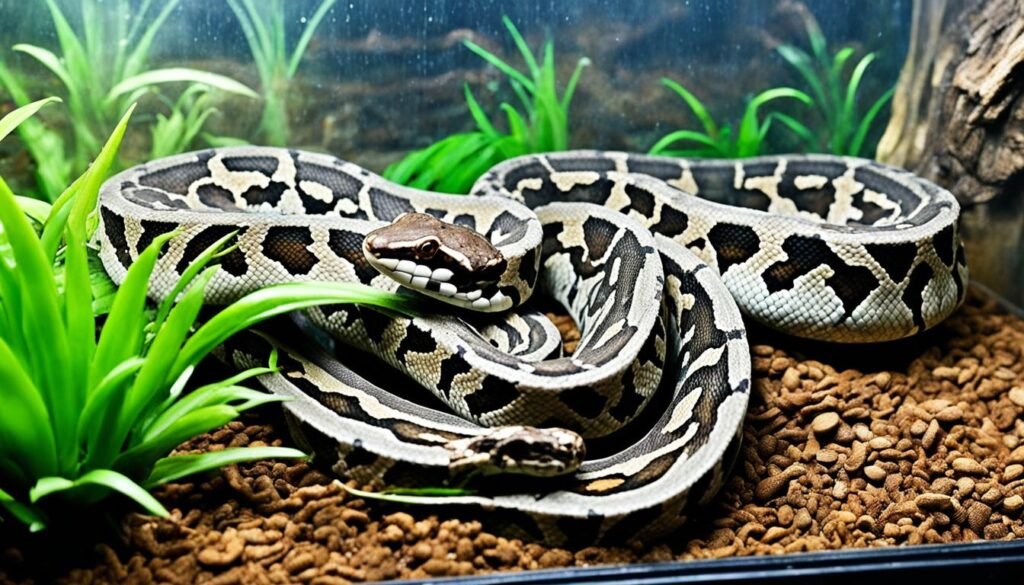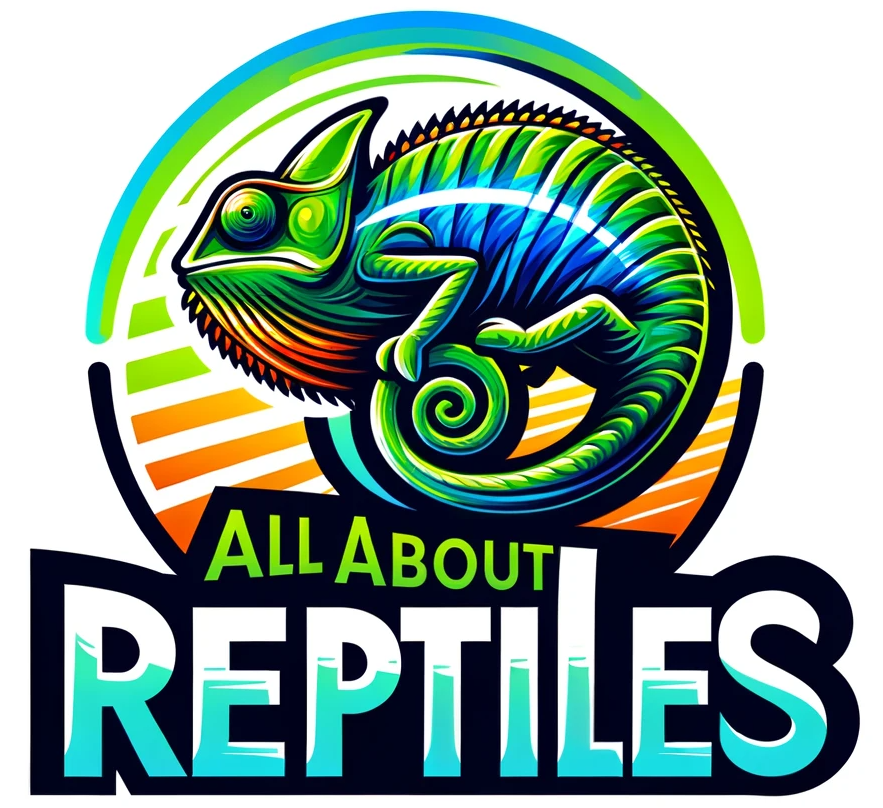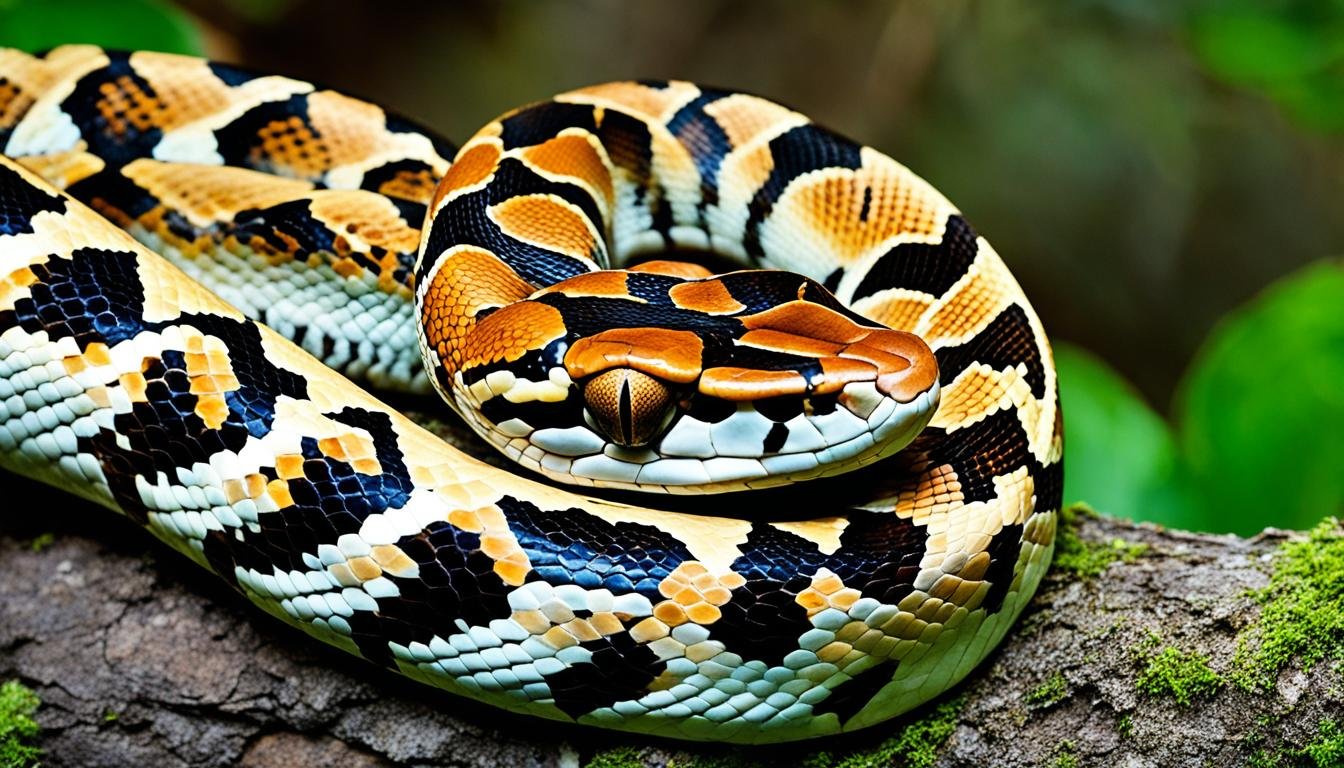Did you know that boa constrictors can live for over 20 years in captivity? These fascinating reptiles are popular exotic pets that require proper care and attention to thrive. Whether you’re a new or experienced owner, this care guide will provide you with valuable tips and important facts to ensure the well-being of your boa constrictor.
From their unique housing needs to their feeding requirements, we’ll cover everything you need to know to keep your boa constrictor happy and healthy. With the right knowledge and care, you can create a fulfilling and enriching environment for your exotic pet.
Key Takeaways:
- Boa constrictors can live for over 20 years in captivity.
- Proper care and attention are crucial for the well-being of your boa constrictor.
- This care guide will provide valuable tips and important facts for boa constrictor owners.
- Topics covered include housing, feeding, handling, and more.
- By following this guide, you can ensure that your boa constrictor lives a healthy and fulfilling life as an exotic pet.
The Colombian Boa Constrictor
The Colombian boa constrictor, also known as the common boa or red-tailed boa, is the most widely kept subspecies in the pet industry. They are popular due to their docile nature and curious behavior. Colombian boas make great pets and are available in various color and pattern morphs. However, they are best suited for moderate- to advanced-level keepers due to their potential size and lifespan.
Colombian boas are a favorite among snake enthusiasts due to their captivating nature. These snakes are known for their calm and friendly dispositions, making them a joy to handle and interact with.
One of the defining features of the Colombian boa constrictor is its red-tailed pattern, which gives it its alternate name. The vibrant red coloration at the tip of the tail is visually striking against the body’s earthy tones.
What sets Colombian boas apart from other subspecies is their ability to thrive in various environments. Whether it’s the tropical rainforests of South America or a well-equipped terrarium in your home, these adaptable snakes can acclimate easily.
When it comes to size and growth rate, Colombian boas are impressive reptiles. While females can reach lengths of 6 to 8 feet, males tend to be smaller, measuring between 5 and 7 feet. These snakes can grow rapidly in their first 6 years, but their growth rate slows as they age. With proper care, Colombian boas can live for several decades, with some individuals reaching over 40 years old.
Colombian Boa Constrictor: Characteristic Features
| Characteristic | Description |
|---|---|
| Size | Females: 6 to 8 feet Males: 5 to 7 feet |
| Lifespan | 20 to 30 years (some individuals can live beyond 40 years) |
| Coloration | Variations of earthy tones with a distinct reddish tail |
| Temperament | Docile, calm, and easily handled |
| Availability | Widely available in the pet industry |
Colombian boas thrive in a well-maintained and spacious enclosure that mimics their natural habitat. These snakes require proper heating, humidity levels, and a suitable substrate to ensure their health and well-being. It is important to provide them with ample hiding spots and visual barriers to create a sense of security.
In terms of diet, Colombian boas primarily feed on appropriately sized rodents. Feeding schedules vary depending on the snake’s age, with younger boas requiring more frequent meals compared to adults.
Remember, owning a Colombian boa constrictor is not to be taken lightly. Their potential size and lifespan require commitment and dedication to provide them with proper care and attention. If you are a novice snake keeper, it is advisable to gain experience with smaller snakes before considering a Colombian boa as a pet.
Availability and Pricing
Boa constrictors are readily available in the pet industry, with many breeders specializing in Colombian boa morphs. These beautiful and captivating snakes are commonly bred in captivity, ensuring a steady supply for enthusiasts and pet owners alike.
Litters of boa constrictors are born throughout the year, with a higher availability during late summer and fall. This consistent breeding ensures that individuals interested in acquiring a boa constrictor can find one without much difficulty.
When it comes to pricing, the cost of boa constrictors varies depending on the type and morph. Normal-colored boas are generally more affordable, making them a great choice for beginners or those on a budget. However, for those looking for something more unique and visually striking, “designer” morphs are available but come with a higher price tag.
It is important to purchase your boa constrictor from a reputable source. This ensures that you are obtaining a healthy and well-cared-for snake. Reputable breeders prioritize their animals’ well-being and can provide you with information about the snake’s lineage and health history.
Boa Constrictor Availability and Pricing Table
| Morph Type | Availability | Average Price Range |
|---|---|---|
| Normal-Colored Boas | High | $100 – $300 |
| “Designer” Morphs | Moderate | $500 – $10,000+ |
As you can see in the table above, normal-colored boas are more readily available, while “designer” morphs may require more effort to find. Additionally, the prices of “designer” morphs can vary greatly depending on rarity and demand.
Remember, the cost of purchasing a boa constrictor is just the beginning. Ensure that you are prepared for the long-term commitment of owning and caring for these incredible reptiles before bringing one into your home.
Size and Lifespan
When it comes to boa constrictors, understanding their size and lifespan is essential for providing proper care. Female Colombian boa constrictors can reach impressive lengths of 6 to 8 feet, while males are slightly smaller, ranging from 5 to 7 feet. Keep in mind that subspecies like Central American boas tend to remain smaller than their Colombian counterparts.
The growth rate of boa constrictors is most significant during the first 6 years of their lives. However, they can continue to grow until they reach around 15 years of age. This means that they require ample space in their enclosures to accommodate their increasing size.
Boa constrictors are known for their longevity among reptiles. On average, they have a lifespan of 20 to 30 years, with some individuals living beyond 40 years. This is a long-term commitment, so be prepared to provide care and attention for your boa constrictor throughout its life.
Size Comparison:
| Category | Length |
|---|---|
| Female Boa Constrictor | 6 to 8 feet |
| Male Boa Constrictor | 5 to 7 feet |
| Central American Boa | Varies (usually smaller) |
Lifespan Comparison:
| Category | Lifespan |
|---|---|
| Average Lifespan | 20 to 30 years |
| Long-Lived Individuals | Above 40 years |
Proper knowledge of boa constrictor size and lifespan will help you plan their housing and care effectively, ensuring a comfortable and healthy life for your beloved reptile companion.
Housing and Enclosure
When it comes to housing your boa constrictor, providing a spacious and secure enclosure is essential for their well-being. Here are some key considerations for creating the perfect boa habitat:
Enclosure Type
While baby boas can initially be housed in glass aquariums, it’s best to transition to custom enclosures made from high-quality plastics as they grow. These custom enclosures help maintain the optimal humidity levels required for boa constrictors.
Size Requirements
Floor space is more important than height when it comes to boa constrictor enclosures. Adult boas should be housed in enclosures that are at least 4 feet long by 2 feet wide, allowing them enough room to explore and move around comfortably.
Structures and Hiding Spots
Providing hide boxes and other structures, such as branches or rocks, not only adds aesthetic appeal to the enclosure but also gives your boa a sense of security. These hiding spots allow your snake to hide and feel safe when needed.
Visual Example:
| Enclosure Type | Size Requirements | Structures and Hiding Spots |
|---|---|---|
| Custom-made plastic enclosure | At least 4 feet long by 2 feet wide | Hide boxes, branches, rocks |
Lighting and Temperature
Proper lighting and temperature control are essential for maintaining the health and well-being of your boa constrictor. These reptiles require a temperature gradient within their enclosure to thermoregulate effectively. Let’s explore the key factors to consider for boa constrictor lighting, temperature, and reptile heating.
Temperature Requirements
Boas thrive in environments that mimic their natural habitat. The cool side of the cage should be maintained at a minimum temperature of 75 degrees Fahrenheit (24 degrees Celsius). On the warm side, the temperature should range around 85 degrees Fahrenheit (29 degrees Celsius), with a hot spot of 90 degrees Fahrenheit (32 degrees Celsius) to provide adequate basking opportunities for your boa.
One of the preferred methods to provide heat for boas is belly heat. Under-cage heating devices such as under-tank heaters or heat cable can be used to create a warm surface that mimics the natural heat absorbed through the snake’s belly. This enables the boa to regulate its body temperature effectively.
Lighting Considerations
Unlike some reptiles, boa constrictors do not require specific overhead lighting. However, low-wattage fluorescent bulbs can be used to create a day/night cycle and enhance visibility for better observation of your boa’s behavior. These bulbs should not emit excessive heat, as boas primarily rely on belly heat for thermoregulation.
| Temperature | Cool Side | Warm Side | Hot Spot |
|---|---|---|---|
| Temperature Range | 75°F (24°C) minimum | Around 85°F (29°C) | 90°F (32°C) |
By providing the appropriate lighting and maintaining the correct temperature gradient, you can create a comfortable and healthy environment for your boa constrictor. Remember to regularly monitor and adjust the temperature within the enclosure, especially during seasonal changes, to ensure your boa’s optimal well-being.
Substrate and Humidity

When setting up the enclosure for your boa constrictor, selecting the right substrate is essential for maintaining proper humidity levels and ensuring your snake’s comfort. Here are some popular options:
- Newspaper: Ideal for young boas, newspaper is inexpensive, easy to clean, and provides a sanitary surface for your snake.
- Aspen Bedding: Made from shredded aspen wood, this substrate is absorbent and helps control odor. It is suitable for both young and adult boas.
- Cage Carpet: A reusable option, cage carpet provides a comfortable surface for your boa and can be easily cleaned and disinfected.
- Reptile Bark: Made from natural materials like cypress or fir, reptile bark retains moisture well, creating a humid environment for your boa constrictor.
To maintain the ideal humidity levels for your boa constrictor (around 60 to 70 percent), mist the enclosure regularly or use a humidifier if necessary. Monitoring the humidity with a hygrometer is recommended to ensure the proper conditions.
Feeding and Diet
Feeding your boa constrictor a proper diet is essential for its health and well-being. Boas are carnivorous reptiles that primarily feed on appropriately sized rodents, such as mice or rats. This natural prey helps them meet their nutritional requirements and maintain good overall health.
When it comes to feeding frequency, young boas (up to 2 years old) require more frequent feedings compared to adult boas. It is recommended to feed young boas every 7 to 10 days to support their rapid growth and development. On the other hand, adult boas can be fed every 3 to 4 weeks as their metabolism slows down.
When selecting prey items for your boa constrictor, it is important to choose rodents that are of an appropriate size. Avoid offering prey items that are larger than the snake’s body girth, as this can lead to digestion issues and potential regurgitation. A good rule of thumb is to offer prey that is no larger in diameter than the thickest part of your boa’s body.
Feeding should always be done using tongs or feeding tools to ensure your safety and prevent accidental bites. Boas, especially when hungry, can be enthusiastic eaters and may mistake your hand for food. Using feeding tools adds an extra layer of protection and helps establish a positive feeding routine.
| Feeding Guidelines for Boa Constrictors by Age | Prey Size | Feeding Frequency |
|---|---|---|
| Young Boas ( | Appropriately sized mice or rats | Every 7 to 10 days |
| Adult Boas | Appropriately sized rats | Every 3 to 4 weeks |
It is important to monitor your boa constrictor’s body condition to ensure you are providing the right amount of food. Overfeeding can lead to obesity and other health issues, while underfeeding can result in malnutrition and stunted growth. Observe your boa’s body shape and adjust the feeding frequency accordingly.
Additional Feeding Tips
- Thaw frozen prey items thoroughly before offering them to your boa. Frozen prey can be thawed in warm water or in the refrigerator.
- Never offer live prey to your boa constrictor, as the prey animal can cause harm to your snake during the feeding process.
- Provide a clean and dedicated feeding area for your boa. This helps prevent the ingestion of substrate during feeding.
- Observe your boa while it is feeding to ensure it swallows the prey item completely. It is normal for boas to constrict their prey before swallowing.
By following these feeding guidelines and providing a proper diet for your boa constrictor, you can support its growth, health, and overall well-being. Remember to always prioritize the safety of both yourself and your snake during feeding.
Handling and Care

Boa constrictors can be tamed and become comfortable with regular handling. However, it is essential to handle them with care due to their strength and potential for constriction. After feeding, avoid handling your boa for at least 24 hours to prevent regurgitation. Regular health checks, including observation of behavior, shedding, and respiratory signs, are necessary to ensure the well-being of your snake. Seek professional help if you suspect any health issues.
Proper Handling Techniques
When handling your boa constrictor, it’s crucial to follow proper techniques to ensure the safety of both you and your snake. Here are some guidelines for handling your boa:
- Approach your boa calmly and confidently, avoiding sudden movements that may startle the snake.
- Support the majority of your boa’s body weight by using both hands to gently lift and hold the snake.
- Keep a firm, but gentle grip on your boa to prevent it from slipping or feeling insecure.
- Avoid squeezing or applying excessive pressure on your boa, as this can cause stress or injury.
- Allow your boa to explore and move around during handling, ensuring it feels secure and comfortable.
- Pay attention to your boa’s body language, such as signs of agitation or stress, and adjust your handling accordingly.
Health Checks and Observations
Regular health checks are essential to monitor the well-being of your boa constrictor. Here are some key aspects to observe and assess:
- Behavior: Observe your boa’s behavior for any changes in activity level, appetite, or unusual habits. Any sudden changes may indicate a health issue.
- Shedding: Monitor your boa’s shedding pattern to ensure it sheds its skin properly. Incomplete shed or retained eye caps can lead to complications.
- Respiratory Signs: Look out for any wheezing, excessive mucus, or labored breathing, which may indicate an underlying respiratory problem.
- Physical Appearance: Regularly inspect your boa’s skin for any wounds, abrasions, or abnormal lumps that may require veterinary attention.
Note: If you notice any concerning symptoms or have any doubts about your boa’s health, it’s best to consult a reptile veterinarian for a thorough examination and appropriate treatment.
| Signs of a Healthy Boa Constrictor | Signs of a Potential Health Issue |
|---|---|
| Alert and active | Lethargy or lack of appetite |
| Regular shedding with no retained skin | Incomplete shedding or retained eye caps |
| Clear, smooth skin without wounds or lumps | Visible wounds, swelling, or abnormal lumps |
| Regular and symmetrical body movements | Unusual movements or difficulty in mobility |
| Regular feeding and healthy digestion | Vomiting, regurgitation, or diarrhea |
Remember, proper handling techniques and regular health checks are crucial for the overall care and well-being of your boa constrictor. By providing a safe and comfortable environment, you can ensure your snake thrives and lives a long and healthy life.
Conclusion
Proper care and attention are crucial for the well-being of boa constrictors. This care guide provides valuable tips and essential facts to ensure that you can provide the best possible care for your pet boa constrictor.
Remember to always prioritize the health and wellness of your snake. Providing a suitable habitat, maintaining proper temperature and humidity levels, and feeding an appropriate diet are essential for their overall well-being.
Seek expert advice when needed, as experienced reptile veterinarians and knowledgeable breeders can provide valuable insights for boa constrictor care. By following this care guide and staying informed about best practices, you can create a fulfilling and enriching environment for your pet boa constrictor.
With the right care, boa constrictors can live long and healthy lives as fascinating exotic pets. Their unique characteristics and captivating behaviors make them a rewarding addition to any reptile enthusiast’s home. Embrace the adventure of boa constrictor ownership and enjoy the wonders of exotic pet maintenance.

